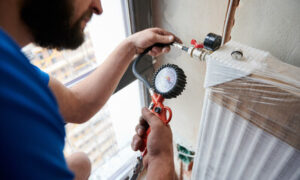Stained Concrete Dallas is an economical way to color existing concrete. Unlike paint, stain penetrates or reacts with the concrete to infuse rich, translucent tones that are resistant to moisture and UV rays.

Stains work best on new and old slabs with minimal cracks or blemishes. Both acid and water-based stains offer a variety of colors.
Concrete staining is one of the more nuanced, finicky and unpredictable decorative concrete techniques, but when it’s done well, it adds a level of elegance to any space. The key is meticulous surface preparation tailored to both topical and reactive stains, ensuring that the concrete is ready to accept the stain and achieve the desired results.
The surface must be free of grime, grease, oil, paint, coatings, curing membranes and any other substance that will inhibit the stain’s ability to penetrate and react. This is typically the most time-consuming and difficult step of the entire process. Using a concrete degreaser and scrub brush, the surface is thoroughly cleaned to remove any gunk, dirt or grease that has built up over time. In some cases, mechanical abrasion methods such as grinding or sanding may be required to ensure that the surface is fully clean and ready for staining.
Older concrete is often harder to prep, as it can be prone to cracking, chipping and other forms of disrepair. It also tends to absorb and hold stains differently than newer, more flexible concrete. This is why it’s critical to test a small section of the concrete before proceeding with the full application, to determine if the surface is capable of accepting and reacting to the stain.
Both acid and water-based stains are compatible with both new and old concrete, as well as plain or integrally colored surfaces. They can be used indoors and outdoors and on a variety of surfaces including floors, patios, pool decks and driveways.
For an added level of visual interest, secondary colors and antiquing effects can be applied to the concrete after the initial stain has dried. Stencils can also be used to create borders, patterns or designs on the concrete before the stain is applied.
Reactive acid stains use chemical reactions with the minerals in the concrete to produce earth-toned hues that are unique and dynamic. They can be applied on new and old concrete, as well as over existing sealers. Non-reactive water-based stains use pigments and acrylic polymers to fill the pores of the concrete, producing vibrant translucent finishes. These stains are low in VOCs and safer to apply than acid-based products.
Staining
Concrete staining is an excellent option for coloring concrete surfaces. It’s a permanent finish and it doesn’t chip or peel away like paint does over time. Staining is typically less expensive than other coloring options and it can yield a wide variety of colors and special effects.
There are two main types of concrete stains — acid and water-based. The staining process itself is relatively simple. The key is proper surface preparation. If the concrete is covered by grime, glues, coatings, curing membranes or sealers, it won’t be able to properly absorb the stain.
When choosing a staining product, it’s important to read the label. It should state whether the stain is reactive or nonreactive. Reactive stains contain metallic salts that react with the concrete’s lime content to produce a unique color. The chemical reaction with the concrete also creates a durable bond that resists chipping and scratching. This type of stain is perfect for achieving earth tones and natural-looking colors.
Water-based stains are formulated with acrylic polymers and pigments to fill the pores of the concrete. They are low in VOCs (volatile organic compounds) and safer to use than acid stains. They are ideal for new, plain or integrally-colored concrete and they work great indoors and out on everything from floors to pool decks.
Both acid and water-based stains are available in a wide range of standard colors as well as black, white and metallics. It’s also common to mix stain colors to achieve unique and interesting hues. When working with stains, it’s important to work in small areas and take the time to properly apply them. If you work too quickly, the stain can unevenly soak into the concrete and result in an unsatisfactory color.
Many people choose to stain concrete because of its durability. It’s an excellent choice for high traffic areas because it doesn’t chip or scratch as easily as other flooring materials. Additionally, stain is a great way to hide imperfections in the concrete such as cracks and blemishes. With a little maintenance, stained concrete will continue to look beautiful for years.
Sealing
As with paint, concrete stain will fade if not protected with a sealer. A good concrete stain and sealer combination protects the surface, prevents dirt from clogging pores and makes it easier to clean. A top coat also prevents fading due to UV radiation, heavy foot traffic or chemical exposure. Typically, a clear, water-based polyurethane or acrylic sealer is used to protect stained concrete floors. Aliphatic polyurethanes are one of the most durable options. They offer nearly twice the thickness of acrylic sealers and come in both matte and high gloss finishes. They are highly resistant to abrasions, chemicals, scuffing and staining and are suitable for indoor or outdoor use.
Staining concrete can create a whole new look, especially for surfaces that would otherwise be bare or covered with other materials such as wood or tile. It’s considered a green renovation because it reuses what is already there, rather than tearing up and starting over.
Stained concrete is relatively inexpensive compared to other flooring options and produces a custom, unique product. However, like any concrete slab, it is not indestructible and requires periodic maintenance and resealing.
A professional concrete contractor is well equipped to prepare, apply and cure the concrete for staining and can provide a variety of color options, both transparent and opaque. The best choice depends on the desired look and application.
Both acid and water-based stains can be applied to new or old, plain or integrally colored concrete. They can be used indoors or outdoors and on a wide range of projects including driveways, patios, pool decks, and garage floors.
Reactive stains (acid stains) utilize inorganic metallic salts and hydrochloric acid to penetrate the concrete to trigger a chemical reaction with its calcium hydroxide content. This creates a marble-like appearance and offers a wide spectrum of color tones from tans, browns, and blues to marbling effects. They require more safety precautions and experience than non-reactive stains, but yield beautiful, rich results.
Non-reactive stains are made up of acrylic polymers and pigments that do not rely on a chemical reaction to penetrate the concrete. They are typically applied with a brush or airless sprayer and can be dripped or dabbed for more textured designs. They can be translucent to almost opaque and are more consistent than acid stains.
Maintenance
Stains add color over bare concrete and sealers form a protective layer on the surface. These two steps make concrete floors much easier to clean than flooring materials like carpet and vinyl. Even so, no flooring material is completely maintenance free. Concrete, while sturdy and durable, is still a porous material that can soak up spills and harbor mildew if not cleaned immediately.
Regularly sweeping or dust mopping your concrete floors with a neutral pH cleaner can prevent dirt buildup and staining. Be sure to clean up any spills immediately and avoid using acidic or abrasive cleaners, which can damage the floor’s finish and concrete itself. Waxing can also help keep your stained concrete floors shiny and easy to clean. However, it is important to note that wax should not be used on outdoor concrete floors, as it can lead to cracks and pitting.
Unlike carpet, stained and sealed concrete floors are low maintenance, but they do require some care to look their best. To reduce wear, consider putting down an area rug in heavily trafficked areas. However, rubber backed throw rugs should be avoided because they can trap moisture under them and cause the concrete to become discolored and smelly.
If stains do occur, there are several cleaning techniques that can be used. For oil and grease stains, try a solution of water and baking soda. For rust stains, pour hydrogen peroxide onto the stain and let it sit overnight. You can then scrape it off with a plastic-edged scraper.

